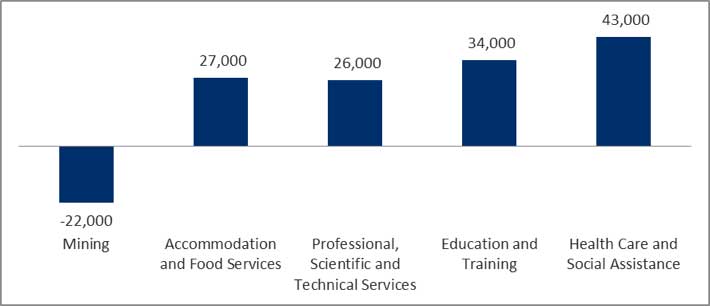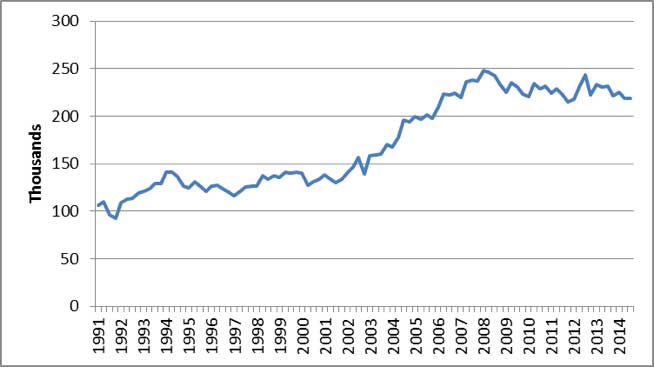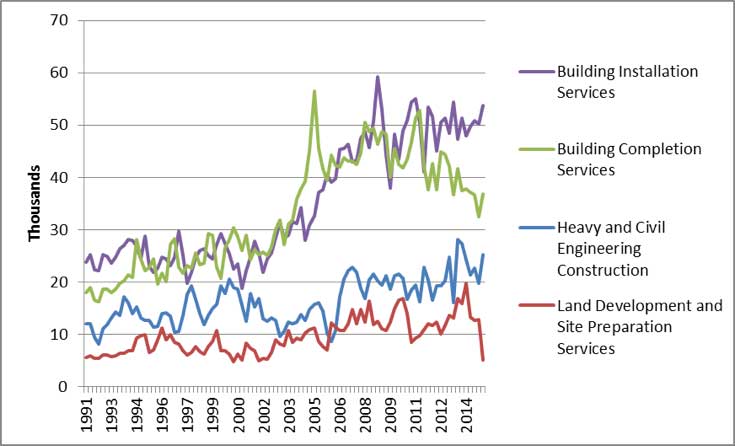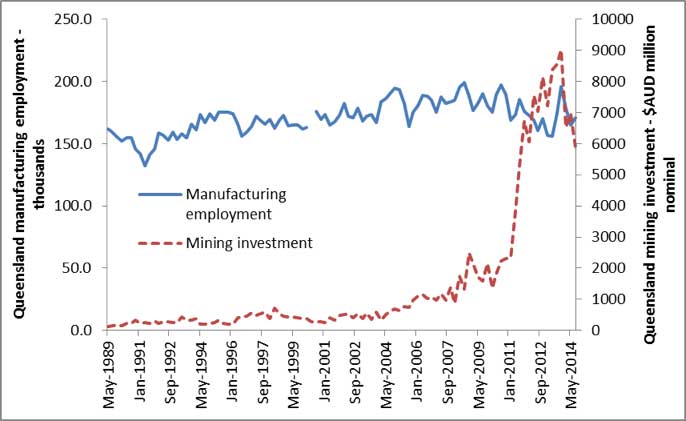One person’s mining boom is another person’s statistical reality. Rod Campbell from The Australia Institute explains.
Last Thursday, I was discussing the idea of drilling for oil and gas in the Great Australian Bight with West Australian senator Chris Back. Major oil company BP has plans to do just that, along with Norway’s Statoil. Yes, the same BP that brought you the Gulf of Mexico oil spill in 2010.
Senator Back has been to some gas projects in WA and liked what he saw. In particular, he liked seeing lots of people working on them. He liked this so much that he was “offended” when I brought up ABS figures showing that oil and gas accounts for only 2 out of every thousand jobs in Australia, some 19,000 people (Senate transcript not up yet, but will go here. ABS figures here – Table 6).
Now, if South Australia wants to drill for oil just next to its tuna industry, coastal tourism industry and breeding areas for whales, albatross and other sealife for the sake of a multinational fossil fuel company, that’s largely a matter for the crow-eaters themselves.
But, they shouldn’t pretend that it’s going to make a significant difference to employment. Basic estimates suggest perhaps 1,500 jobs might be created if oil is ever produced in the Bight, while SA’s workforce is over 800,000 strong (see The Australia Institute’s submission here).
Oil lobby group APPEA told Senator Back and the rest of the Senate environment committee that there were some “red herrings” in this submission, which was “misleading” with the ABS numbers. They stood by their claim of drilling’s “potentially enormous” economic benefits and employment growth.
The fact is, oil, gas and mining industries are “capital intensive” – they use a lot of expensive machinery, but don’t actually employ many people. All of the resource industries combined employ just 2 per cent of Australia’s workforce.
The reason why this is hard for sensitive people like Senator Back to accept, is that lobbyists like APPEA keep putting out reports about all the “indirect jobs” that mining, oil and gas supposedly creates in other industries.
Here’s APPEA’s report claiming 100,000 jobs. APPEA are totally outdone by the Queensland Resource Council that has a report claiming credit for 365,866 mainly “indirect” jobs in that state alone.
The idea is simple – because mines and oil rigs build things, they must be responsible for jobs in construction. They buy equipment, so must make jobs in manufacturing. Their employees eat pies so must make jobs in baking, retail and agriculture. Right?
Wrong. If a mine or oil rig doesn’t buy construction services, manufactured equipment or pies, almost all of these things get sold to a different project, or some other industry, or another pie eater. Almost all. There is some difference, which can be important for particular businesses, regions or industry niches, but most of the inputs to a mine or oil rig would go to some other use in the absence of that project.
If South Australia wants to have a jobs boom, maybe they could look at what’s happening in Queensland. Last week, the Queensland Jobs Growth Summit, heard that despite the end of the mining boom, employment numbers in the state were up. While employment in mining has declined, four other industries had increased employment by more than mining had decreased:
Employment change in selected Queensland industries, Nov 2013 to Nov 2015

Source: ABS Cat no. 6291.0.55.003 Labour Force, Australia, Detailed, Quarterly also see here.
Still not convinced? Well, let’s go looking for those pesky indirect jobs! (Readers easily offended by ABS statistics look away now!)
Did mining make a lot of indirect construction jobs in Queensland during the mining boom? If you look at overall construction employment in the state, it sure looks like it. After being steady for years, construction employment increased considerably from 2001 to 2008:
Construction employment in Queensland

Source: ABS 2015 Labour Force, detailed, quarterly also see here.
But let’s look closer. If we look at what type of construction drove this increase, we see that it was mostly Building Completion and Installation Services – things like plumbing, air conditioning, plastering, tiling, painting and glazing:
Construction employment in Queensland by sub sector

Source: ABS 2015 Labour Force, detailed, quarterly
The increases in these parts of the industry are driven not by mining, but by increased housing and apartment construction. Population growth, strong economic growth and huge amounts of credit directed towards residential property have contributed to this growth.
Mining related construction – heavy engineering and site preparation services – did grow through the boom, but they weren’t the big numbers in Queensland construction.
In fact, in the early parts of the mining boom, we didn’t actually build many new mines. Resource prices went up a lot through the early 2000s, but it wasn’t until later that a lot of money was spent and shovels stuck in the ground to make new mines in Australia. Construction employment in Queensland declined overall during the huge spike in mining investment:
Queensland construction employment vs private sector spending on heavy industry construction

Source: ABS 2015 Labour Force, detailed, quarterly, ABS 5625.0 Private New Capital Expenditure and Expected Expenditure, Australia
Manufacturing employment was similarly unaffected by most of the mining boom. Despite the perception that mining, oil and gas buy lots of equipment and therefore support manufacturing, this just isn’t the case. Manufacturing employment in Queensland has shown no clear trend for decades. The vast amount of mining investment since 2009 has made no discernible impact on overall manufacturing employment in Queensland:
Queensland manufacturing employment and mining investment

Sources: ABS 6291.0.55.003 Labour Force, Australia, Detailed, Quarterly and ABS 5625.0 Private New Capital Expenditure and Expected Expenditure, Australia
Despite this, the Queensland Resource Council would have you believe that it is the impact of its members that is responsible for 42,443.1 manufacturing jobs in Queensland (Table 4). Yes, they claim to have calculated this down to the nearest 0.1 of a job.
The mining boom really was a boom for shareholders in mining companies and for people who work in the mining industry. Some particular regions and towns saw substantial increases in employment, but there was no boom in “indirect jobs” in other industries.
Queensland is discovering that the end of the mining boom has a minimal effect on its employment levels. Equally, South Australia should realise that an oil industry in the Great Australian Bight won’t significantly contribute to employment in the state and that it comes with risks to other industries.
If you’re offended by these ideas you should avoid the ABS website at all costs. Also consider moving to WA and a run for the Senate.
Donate To New Matilda
New Matilda is a small, independent media outlet. We survive through reader contributions, and never losing a lawsuit. If you got something from this article, giving something back helps us to continue speaking truth to power. Every little bit counts.





